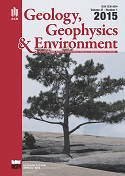Removal of heavy metals from waste water using a hybrid membrane process
DOI:
https://doi.org/10.7494/geol.2015.41.1.130Abstract
Soil and water pollution by heavy metals is currently a very important problem in environmental and other sectors. The origin of metals in water may be of either natural character (erosion of rocks and sediments, leaching of mineral resources) or anthropogenic character (mining and extraction of metals, industry, agriculture, etc.) (Martins et al. 2010). Many heavy metals, such as Pb, Cd, Cu, Zn, etc., are the most polluting factors in industrial wastewater and may get into the ground water. Subsequently they are bio-accumulated in living organisms and cause various diseases and disorders (Jamil et al. 2010). These problems need to be responded by developing new and more efficient methods for wastewater treatment (Martins et al. 2010). In practice several methods are used for removal of heavy metals from water. One of the promising methods for the removal of metal ions from water is a hybrid membrane processes. This method includes two processes – adsorption of metal ions on the natural zeolite and microfiltration of zeolite suspension through ceramic membrane. Experiments were carried out using model solutions containing Cu2+ ions (from CuSO4.5H2O and Cu(NO3)2.3H2O) and Zn2+ ions (from ZnSO4.7H2O and Zn(NO3)2.6H2O).
In the experiments zeolite from Nižný Hrabovec localization (Zeocem JSC Bystré), Slovakia was used. Zeolite is mainly composed of mineral clinoptilolite (84%), other mineral are cristobalite (8%), clay (4%) and plagioclase (3-4%). Its structure is formed by three-dimensional network. Clinoptilolite is composed from silicate tetrahedron (SiO4)4- bound together by oxygen atoms, where part of the Si atoms is replaced with aluminum (AlO4)5-. This creates space structures with a number of cavities and channels, in which are accommodate metal cations and water molecules. The total volume of cavities is 24 to 32%. Zeolite has a bulk density of 1600 to 1800 kg.m-3, a specific gravity of 2200 to 2440 kg.m-3 and the specific surface of 30 to 60 m2.g-1 (www.zeocem.com).
Adsorption experiments on model solutions were performed with the zeolite with particle size 20 microns. Before and after the experiments the concentrations of Cu and Zn were determined by atomic absorption spectrophotometry (AAS) using iCE 3300 AA Spectrometer Thermo Scientific. Solutions with concentrations of 10 to 5000 mg.l-1 were prepared from each of the chemicals. The solutions were shaken with 1 g of zeolite in 100 ml PET flasks on a shaker for 2.5 hours at 25°C and 220 rpm. The amounts of metals (Cu or Zn) in solutions were measured after stabilization, filtration and required dilution by AAS. The equilibrium between the concentration in solution and the adsorbed substance was evaluated using Langmuir, Freundlich and Redlich-Peterson models. According to the results of the adsorption experiments zeolite adsorbed of both the nitrates ions (Cu2+ and Zn2+) (equilibrium concentrations 1.48 mg.g-1 and 1.49 mg.g-1, respectively) best and the sulfate ions (0.34 mg.g-1 and 0.85 mg.g-1, respectively) less. Due to better adsorption capacities of zeolite for ions derived from nitrates, further experiments were made from chemicals Cu(NO3)2.3H2O and Zn(NO3)2.6H2O.
The next step was microfiltration of suspension of zeolite since a hybrid process for removal of Cu and Zn ions was used. Microfiltration was carried out at a constant pressure of 50 kPa, the flow rate of suspension 2.2 m.s-1 and various concentrations of zeolite (1 g.l-1 to 6 g.l-1). Tubular Membralox ceramic membrane was used, with length of 25 cm, internal diameter of 0.5 cm, external diameter of 0.7 cm and porosity of 50 nm. Active surface of the membrane was 49.48 cm2. Zeolite was added to the solution of ions circulating in the cross-flow microfiltration system. Metal ions were adsorbed by zeolite and the suspension was filtered by the membrane. The adsorbed metal remained circulating in the system and the permeat was purified water. Using this method, at suitable selection of the experimental conditions, up to 90 to 100% of metal ions can be removed from the solution.
Downloads
References
Martins A., Mata T.M., Gallios G.P., Václaviková M., Stefusova K., 2010. Modeling and simulation of heavy metals removal from drinking water by magnetic zeolite. Water Treatment Technologies for the Removal of High-Toxicity Pollutants, Springer Science, 61-83.
Jamil T.S., Ibrahim H.S., Abd El-Maksoud I.H., El-Wakeel S.T., 2010. Application of zeolite prepared from Egyptian kaolin for removal of heavy metals:I. Optimum conditions. Desalination 258. 34-40.
Downloads
Published
Issue
Section
License
Authors have full copyright and property rights to their work. Their copyrights to store the work, duplicate it in printing (as well as in the form of a digital CD recording), to make it available in the digital form, on the Internet and putting into circulation multiplied copies of the work worldwide are unlimited.
The content of the journal is freely available according to the Creative Commons License Attribution 4.0 International (CC BY 4.0)










